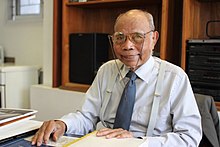Vann Molyvann | |
|---|---|
 Vann Molyvann | |
| Born | 23 November 1926 Kampot province, Cambodia |
| Died | 28 September 2017 (aged 90) Siem Reap, Cambodia |
| Alma mater | École Nationale Supérieure des Beaux-Arts |
| Occupation | Architect |
| Movement | New Khmer Architecture Modernism |
| Buildings | |
Vann Molyvann[1] (Khmer: វណ្ណ ម៉ូលីវណ្ណ; 23 November 1926 – 28 September 2017) was a Cambodian architect and urban planner. Molyvann is best known as pioneering the style known as New Khmer Architecture, which combined modernism and Khmer tradition, and accounted for the country's unique environment and irrigation needs.
During Cambodia's post-independence period between 1957 and 1970, Molyvann was appointed by Norodom Sihanouk to reshape and modernise Cambodia through the construction of new towns, infrastructure and architecture. He is credited with modernising the nation's capital Phnom Penh and designing several iconic landmarks, including the Independence Monument, Chaktomuk Conference Hall and Olympic Stadium.[2] During the Cambodian Civil War and Pol Pot regime, he lived in exile in Switzerland, returning to Cambodia in 1991. He was appointed head of APSARA, in charge of conserving the temples of Angkor, until his dismissal in 2001 following disputes with the government. In contemporary Cambodia, many of his buildings and city plans fell into neglect or were demolished by unplanned development. He died in 2017 at age 90.
- ^ Grant Ross Helen and Collins Darryl Leon: Building Cambodia: 'New Khmer Architecture' 1953-1970, Bangkok: The Key Publisher, 2006 ISBN 974-93412-1-X Chapter 7 devoted entirely to Vann Molyvann
- ^ Cite error: The named reference
:1was invoked but never defined (see the help page).